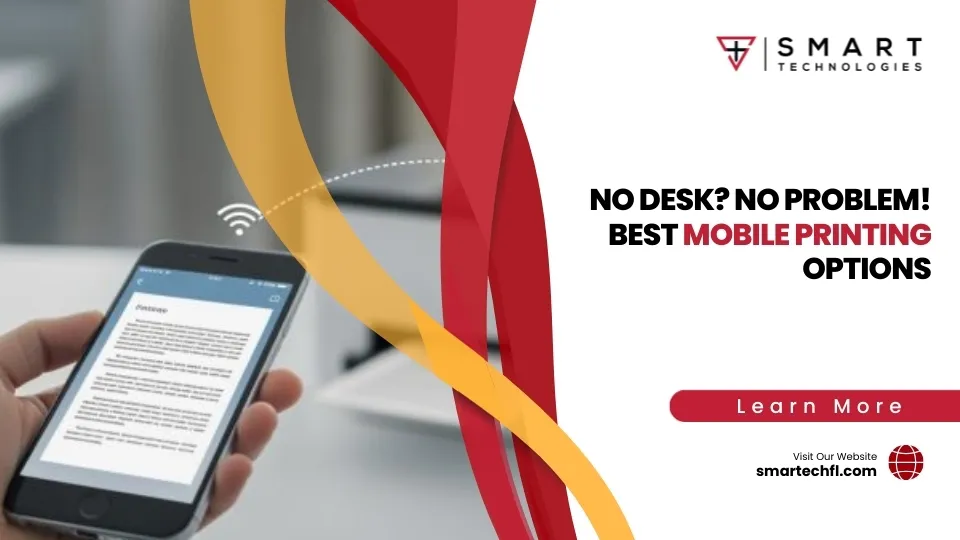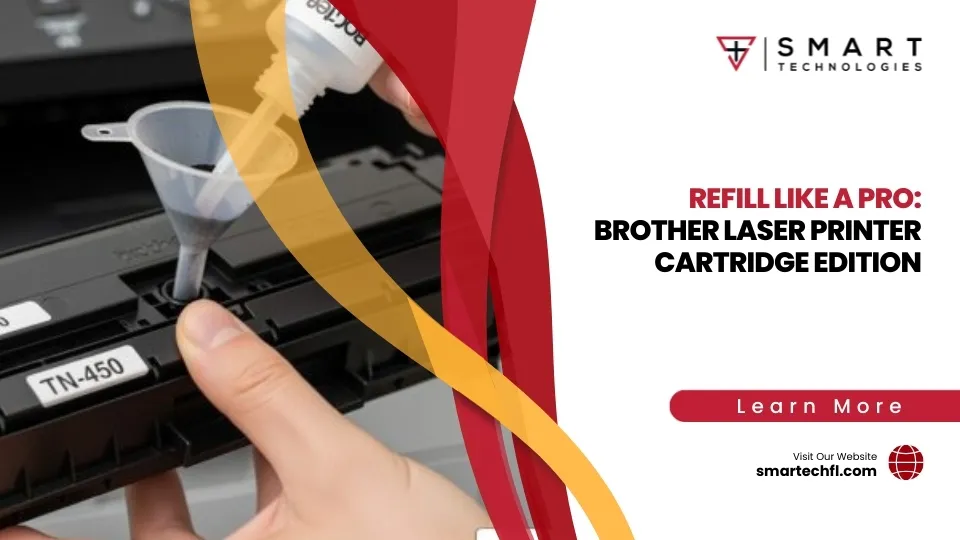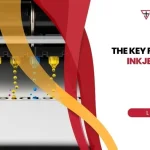Eco-Friendly Printing: How to Save the Planet One Page at a Time
Sustainable printing practices combine eco-friendly materials, energy-efficient technologies, and waste reduction strategies to minimize the environmental impact of printing operations. For businesses looking to implement more sustainable printing, here are the core practices:
- Use recycled or FSC-certified paper (reduces deforestation)
- Switch to plant-based inks (soy/vegetable instead of petroleum)
- Enable double-sided printing by default (cuts paper use up to 50%)
- Implement print management software (reduces waste and tracks usage)
- Upgrade to ENERGY STAR certified devices (lowers electricity consumption)
- Recycle ink and toner cartridges (prevents e-waste)
- Adopt digital workflows when possible (minimizes unnecessary printing)
In 2025, sustainable printing isn’t just an environmental choice—it’s smart business. With the global sustainable printing market valued at $2.07 billion in 2023 and growing at 7.5% annually through 2030, companies are recognizing both the ecological and financial benefits of greener printing practices.
The numbers tell a compelling story: the average office worker uses 10,000 sheets of paper annually (roughly one tree’s worth), and printing-related costs typically account for about 3% of a company’s overall expenses. Perhaps most shocking is that 65% of printed documents are thrown away or recycled the same day they’re printed.
Beyond waste reduction, sustainable printing delivers measurable business advantages. Research shows that 70% of consumers prefer eco-friendly brands, and 44% are more likely to buy from companies with clear sustainability commitments. In some markets, like the Philippines, 81% of shoppers are willing to pay more for sustainable products.
For retail businesses undergoing digital change, incorporating sustainable printing practices offers a perfect opportunity to modernize operations, reduce costs, and strengthen customer relationships—all while lessening environmental impact.
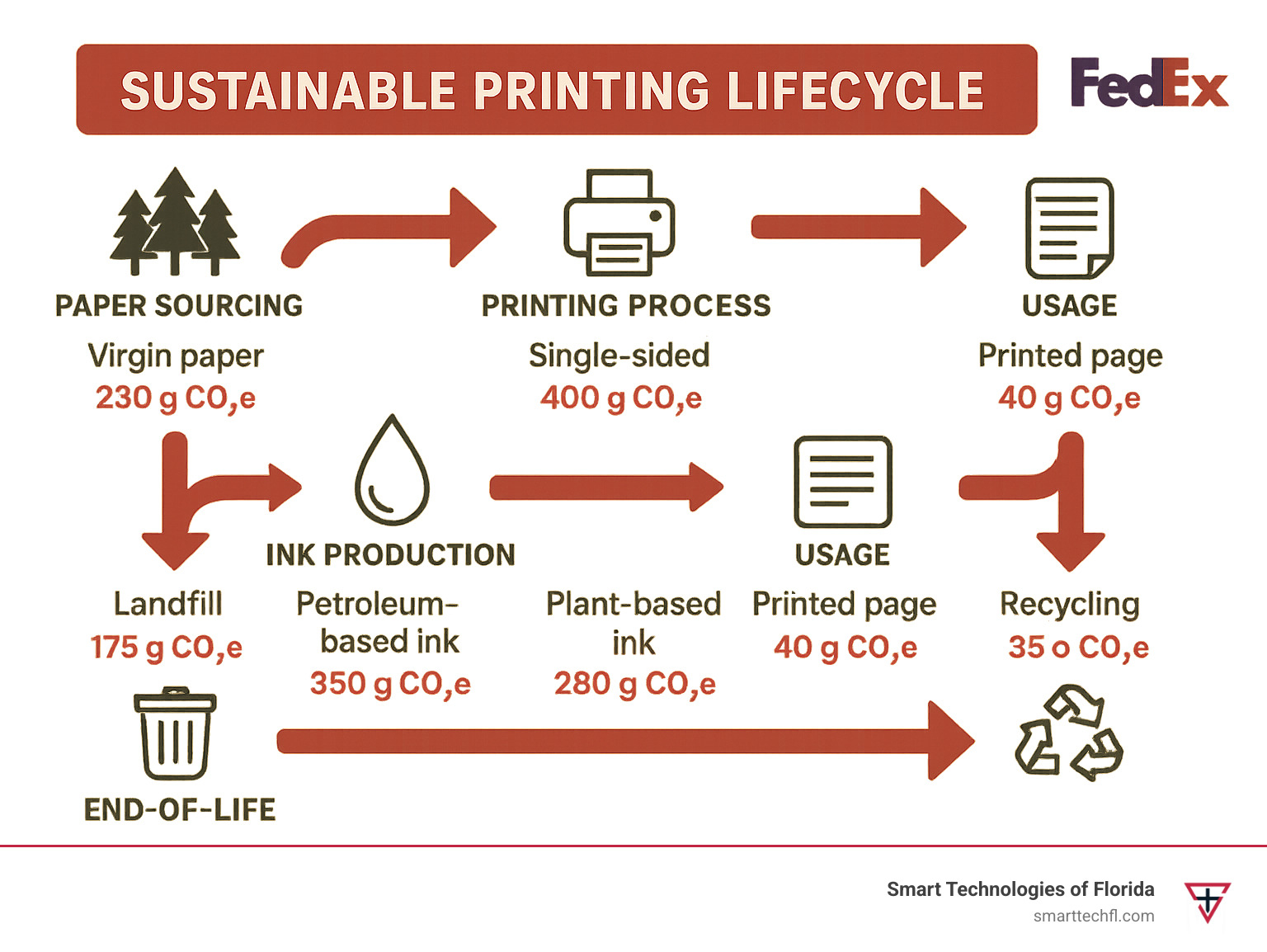
Why Sustainable Printing Matters in 2025
Let’s face it—printing isn’t going away anytime soon. But in 2025, the conversation around printing has completely changed. What was once just an office necessity has become a focal point for environmental responsibility and smart business practice.
The numbers tell a sobering story. Despite digital change efforts, our global paper appetite remains massive. While print volumes dipped 14% in 2020 (to 2.8 trillion pages), the environmental impact is still staggering. Think about this: 35% of all trees harvested worldwide end up as paper products. And those 500+ million ink cartridges tossed annually? They’ll still be sitting in landfills when your great-grandchildren are born.
The regulatory landscape is shifting beneath our feet too. Take Catalonia’s 2025 Waste Prevention Act, which will outright ban single-use printer consumables. This isn’t an isolated case—similar regulations are spreading globally, pushing manufacturers toward refillable and remanufactured alternatives whether they’re ready or not.
Energy costs continue their upward climb, making those old energy-guzzling printers increasingly expensive to operate. Modern sustainable printing practices like using ENERGY STAR certified devices can slash energy consumption by up to 30%—savings that go straight to your bottom line.
Perhaps most compelling is what your customers are saying with their wallets. 70% of consumers now prefer eco-friendly brands, and many will happily pay more for sustainable products and services. By 2025, over one-fifth of companies expect more than 30% of their revenue to come from sustainable offerings—up dramatically from just 8% in 2023.
Environmental Toll of Traditional Printing
The hidden environmental costs of traditional printing run deeper than most realize. When we talk about paper, we’re really talking about trees—lots of them. The paper industry claims 35% of all harvested trees globally, directly contributing to habitat destruction and reducing our planet’s natural carbon-capturing abilities.
Water usage in paper production is equally shocking. That single sheet of A4 paper on your desk? It took between 2 and 13 liters of water to produce. Do the math for an average office worker using 10,000 sheets annually, and you’re looking at potentially 130,000 liters of water—enough to fill a small swimming pool.
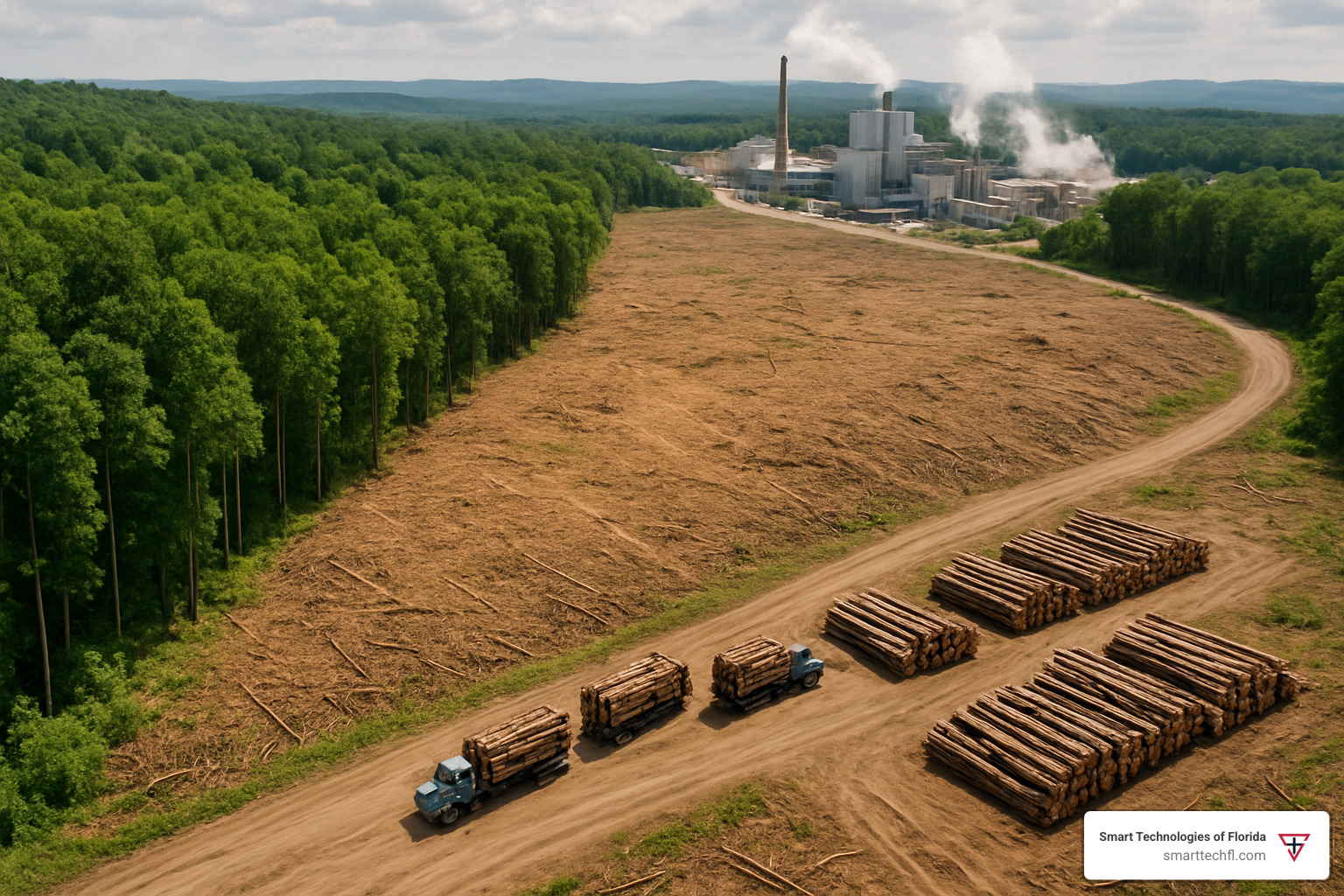
Traditional petroleum-based inks release volatile organic compounds (VOCs) that degrade air quality and can trigger respiratory issues. These same inks complicate recycling efforts and find their way into our water systems.
When paper ends up in landfills—and sadly, much of it does—it generates methane as it decomposes. This greenhouse gas packs 25 times the warming punch of carbon dioxide, making proper paper recycling or composting crucial.
The e-waste situation is equally troubling. Those 500 million discarded ink cartridges each year contain a cocktail of plastics, metals, and residual inks that can take up to 1,000 years to break down, all while leaching contaminants into soil and groundwater. According to scientific research on paper impact, the cumulative effect is far greater than most businesses realize.
Business Risks of Ignoring Sustainability
Beyond environmental concerns, ignoring sustainable printing practices creates tangible business risks that affect your bottom line.
First, there’s the hidden cost factor. Printing typically consumes about 3% of a company’s overall budget—not a massive percentage, but significant when you consider this expense often flies under the radar. Without proper management, these costs remain invisible yet substantial.
Your IT team feels the pain too. Print-related issues devour between 40-60% of IT help-desk time in typical organizations. Imagine redirecting those valuable technical resources toward innovation instead of clearing paper jams and troubleshooting printer errors.
Customer relationships are increasingly at stake. A striking 84% of consumers report they would actively avoid brands with poor environmental practices. As sustainability becomes a core value for consumers, your printing practices are no longer just an internal concern—they’re part of your public image.
Regulatory compliance represents another growing concern. As environmental regulations tighten globally, non-compliant companies face increasing financial penalties. Simultaneously, businesses miss out on tax incentives, grants, and other financial benefits available to environmentally responsible organizations.
The competitive landscape is shifting too. Companies embracing sustainability are outperforming their less eco-conscious competitors by 2-3 times on profit margins and customer loyalty. This performance gap continues to widen, creating clear market winners and losers.
Even your recruitment efforts suffer when sustainability takes a back seat. Today’s talent—particularly younger workers—increasingly considers environmental responsibility when choosing employers. A weak sustainability profile can significantly hamper your ability to attract top talent in competitive markets.
The business case is crystal clear: ignoring sustainability isn’t just an environmental oversight—it’s a strategic miscalculation that directly impacts your company’s future. As the team at Channel Sustainability Trends 2023 highlights, sustainable printing has moved from a nice-to-have to a business imperative.
Core Sustainable Printing Practices (The Ultimate Checklist)
Going green with your printing doesn’t have to feel like climbing a mountain. We’ve put together a friendly, comprehensive guide to help transform your printing operations into an eco-friendly powerhouse:
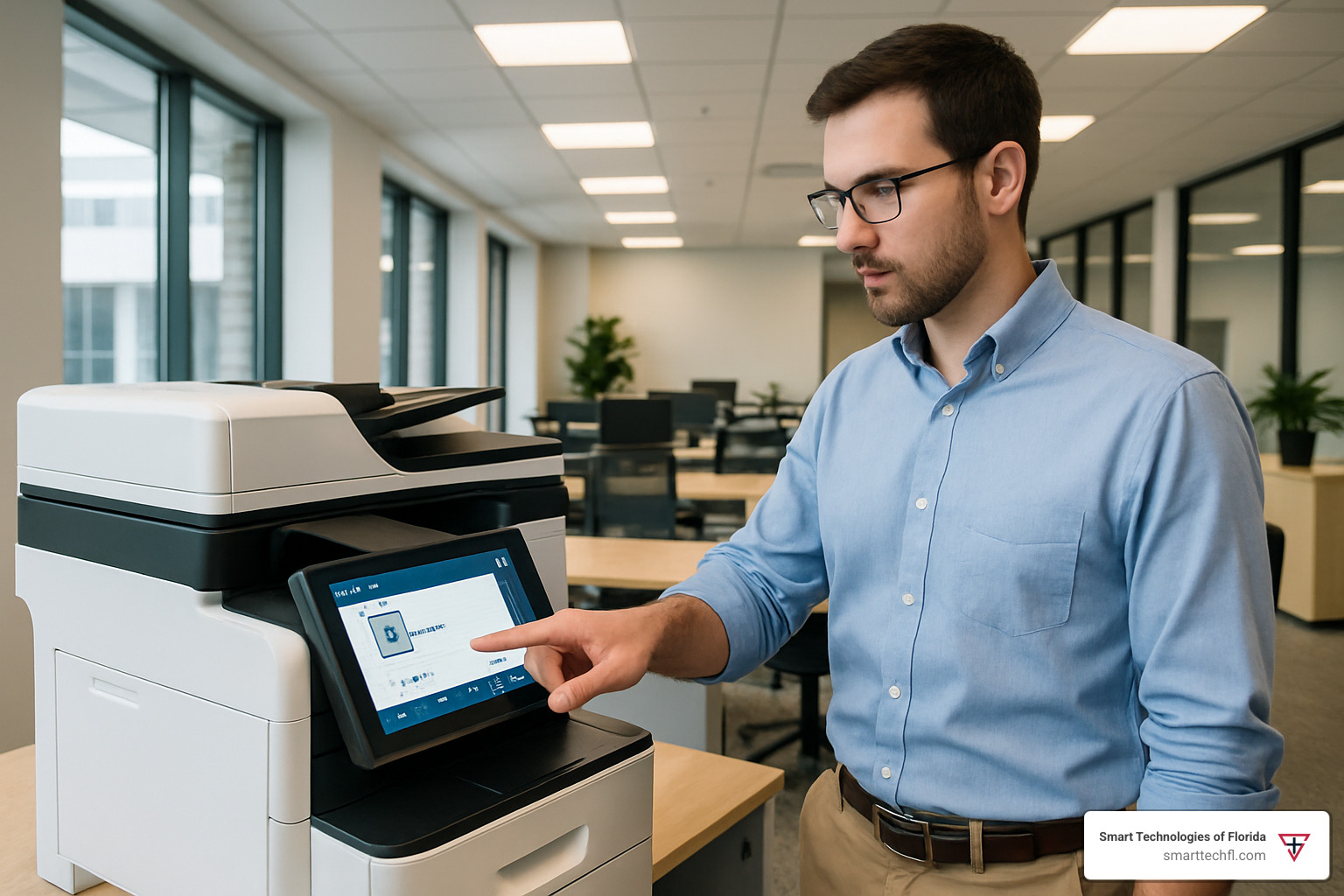
Reduce, Reuse, Digitize—Foundational sustainable printing practices
Old saying about the best offense being a good defense? Well, the most sustainable page is the one you never print in the first place.
Start by setting your printers to default to duplex printing (that’s printing on both sides). This one simple change can slash your paper consumption by up to 40%! You’d be amazed how quickly those savings add up. For internal documents or reference materials, try N-up printing to fit multiple pages on a single sheet.
Before hitting that print button, take a moment to use print preview. It’s a quick way to catch formatting hiccups that might waste paper and ink. And speaking of waste, why not create a paper reuse tray for those single-sided prints? They make perfect draft paper for internal use.
Digital alternatives can make a huge difference too. Instead of photocopying, accept scan-to-email workflows. Modern smartphones even have apps that turn them into high-quality document scanners. For documents that just need a signature, tools like DocuSign let you accept e-signatures without printing a single page. And when you need to share documents, cloud platforms like Google Drive or Microsoft SharePoint eliminate the need for physical copies entirely.
Want to get even more from each page? Try adjusting document settings like margins, font size, and spacing to fit more content on fewer pages. And don’t forget to track your usage so you can identify reduction opportunities and measure your progress. For more tips, check out Sustainable Printing Tips from NYU.
Sustainable Materials & Inks
The materials you choose matter just as much as how you use them.
When buying paper, look for FSC and PEFC certifications. These labels from the Forest Stewardship Council (FSC) and Programme for the Endorsement of Forest Certification ensure your paper comes from responsibly managed forests. Even better, use recycled content paper with high post-consumer waste (30-100%). For every ton of recycled paper you use, you’re saving 17 trees, 1,440 liters of oil, and 4,000 kWh of energy!
If you want to go further, consider alternative fiber papers made from fast-growing materials like bamboo, jute, or agricultural waste. These renewable resources grow much faster than trees, making them a more sustainable option.
Your ink choices matter too. Plant-based inks like soy or vegetable-based alternatives are more biodegradable than petroleum-based inks. They even produce brighter colors while making paper easier to recycle! Look for low-VOC formulations to reduce harmful emissions, and for digital printing, consider water-based toners that minimize environmental impact.
Don’t forget about those empty cartridges! Participate in cartridge recycling programs through manufacturer take-back initiatives or third-party recycling services to keep those cartridges out of landfills. Research from soy ink benefits shows these alternatives are not only better for the planet but often produce superior print quality too.
Smart Devices & Right-Sizing Your Fleet
The equipment powering your printing needs deserves careful consideration.
Start by choosing ENERGY STAR certified devices that represent best-in-class energy efficiency. When comparing models, look at their TEC (Typical Electricity Consumption) values—lower numbers mean less energy use. Features like deep sleep modes and fast warm-up times ensure minimal power usage during idle periods while encouraging users to let devices rest when not in use.
Be smart about when your printers are on. Set up automatic power scheduling to align with your office hours and eliminate standby consumption. For complete peace of mind, smart plugs can fully power down printers when not in use, eliminating that sneaky phantom power draw.
Take a look at your overall print environment too. Often, fleet consolidation—replacing multiple single-function devices with fewer multifunction printers—can dramatically reduce energy consumption and resource use. A right-sizing assessment or print fleet audit helps identify underused devices and optimize placement based on actual usage patterns. For more on optimizing your print environment, check out 5 Reasons to Implement Managed Print Solution Within Your Office.
Print Management & Tracking Software
The right software can be your best ally in reducing waste and improving efficiency.
Secure print release (also called pull printing) requires user authentication at the device, preventing those unclaimed prints from piling up and being tossed. You can also set print quotas and rules by user, department, or document type to discourage unnecessary printing.
System-wide default print settings (duplex, black and white, draft quality) make eco-printing the path of least resistance, while still allowing overrides when needed. To keep track of it all, deploy software with usage analytics that reveals printing patterns and helps measure your sustainability improvements.
Modern workflows call for flexibility. Mobile printing enables secure printing from any device, reducing dependence on desktop computers. Automated workflows can digitize paper-based processes entirely, while print job routing automatically directs jobs to the most efficient device based on specific requirements. For improved security alongside sustainability, look into Reducing Security Vulnerabilities in Your Print Network.
Want to increase accountability? Cost allocation features track printing costs by department or project, raising awareness and often naturally reducing waste.
Here at Smart Technologies of Florida, we’ve seen businesses reduce their printing costs by 20-30% through these sustainable printing practices, all while significantly reducing their environmental footprint. That’s what we call a win-win!
Innovations Driving Sustainable Printing in 2025
The sustainable printing landscape is evolving at lightning speed, with exciting innovations changing how we think about printing in 2025. These advancements aren’t just good for the planet—they’re revolutionizing efficiency and opening new possibilities for businesses.
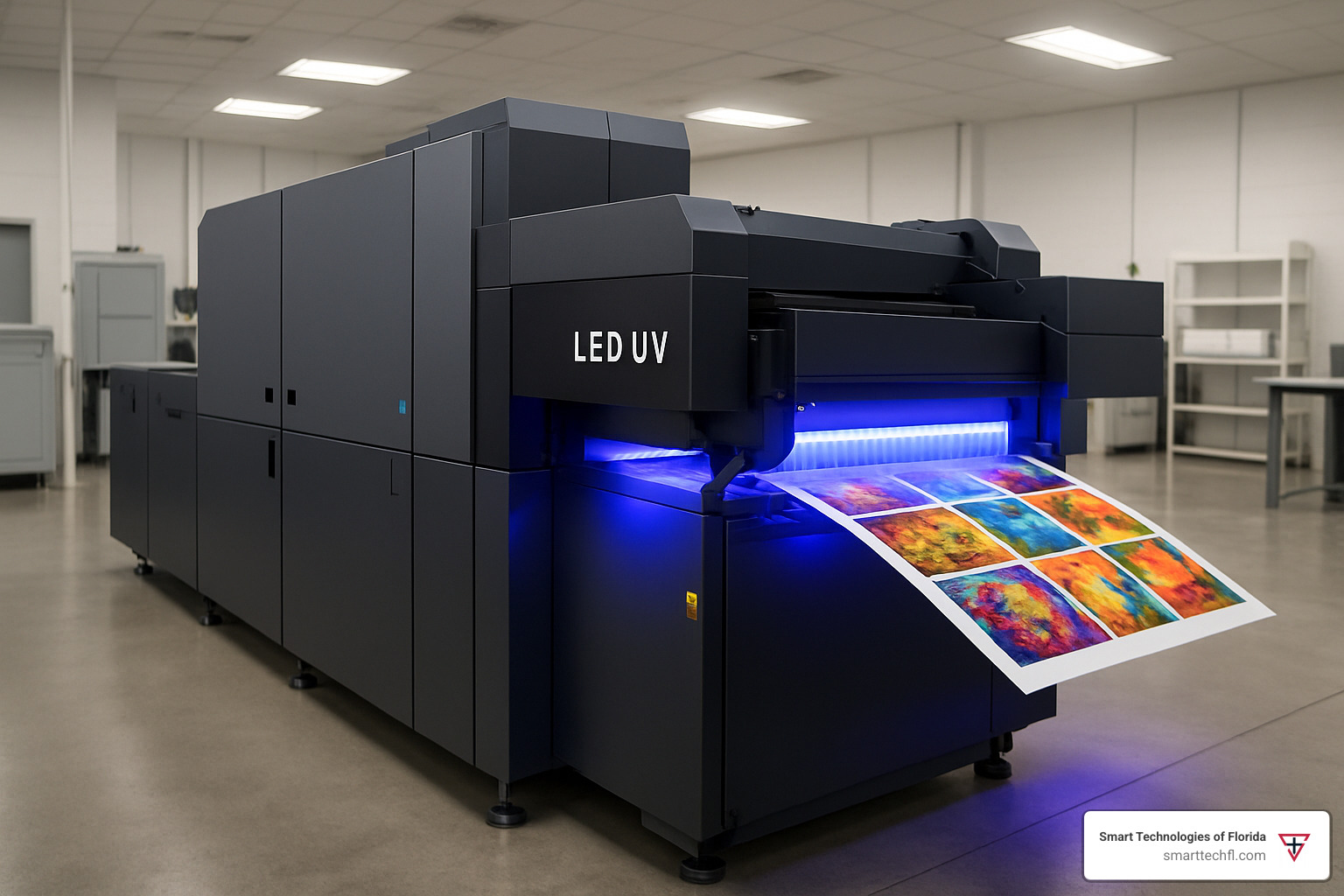
Digital & On-Demand Printing
Remember the days of massive print runs “just in case” you needed extra copies? Those days are thankfully behind us. Digital printing has completely transformed how we approach sustainable printing practices.
Today’s digital presses work without plates, films, or harsh processing chemicals—dramatically cutting waste and eliminating toxic byproducts that once plagued traditional printing. The ability to print exactly what you need, when you need it, means businesses no longer waste resources on excess inventory that might end up unused.
What’s particularly impressive is how digital presses produce about 10% less waste during setup compared to traditional offset methods. And with Variable Data Printing (VDP), your communications can be personalized for each recipient, making them more relevant and less likely to end up in the recycling bin.
The energy savings are substantial too. Modern LED-UV curing technology uses 80% less energy than old-school mercury-vapor UV lamps, while producing zero ozone and much less heat. Some advanced presses have even eliminated water from the equation, doing away with dampening solutions that once consumed gallons of water and chemicals.
For businesses with varied printing needs, hybrid presses offer the best of both worlds—combining digital and conventional technologies to optimize efficiency based on run length and specific requirements.
Workflow Automation & Imposition Software
Smart software has become the unsung hero of sustainable printing practices. Today’s intelligent systems do far more than just send documents to printers—they maximize every sheet of paper and drop of ink.
Imagine software that automatically arranges multiple jobs on a single sheet to minimize waste, or systems that ensure precise cutting to eliminate excess trimming. These aren’t futuristic concepts—they’re today’s reality, reducing material waste while speeding up production.
Error-free finishing through automated slitting, cutting, and creasing has virtually eliminated the scrap piles once common in print shops. When systems communicate seamlessly through JDF connectivity, the entire workflow becomes more efficient, with fewer errors and less rework.
AI has entered the picture too, with predictive maintenance systems that can anticipate equipment issues before they cause waste or downtime. Color management systems ensure you get accurate colors on the first try, eliminating the need for reprints due to mismatched colors.
For businesses juggling complex printing needs, these automation tools are game-changers. They not only reduce material waste but also speed up turnaround times—a win-win for both sustainability and productivity.
Carbon Footprint Calculation & Reporting
Transparency has become non-negotiable in 2025, with businesses and consumers alike wanting to understand the environmental impact of their choices—including printing.
Sustainable printing practices now include sophisticated carbon calculators integrated directly into print management systems. These tools provide immediate carbon footprint data for each print job, helping businesses make informed decisions. Client-visible dashboards show customers the environmental impact of their print choices and suggest greener alternatives.
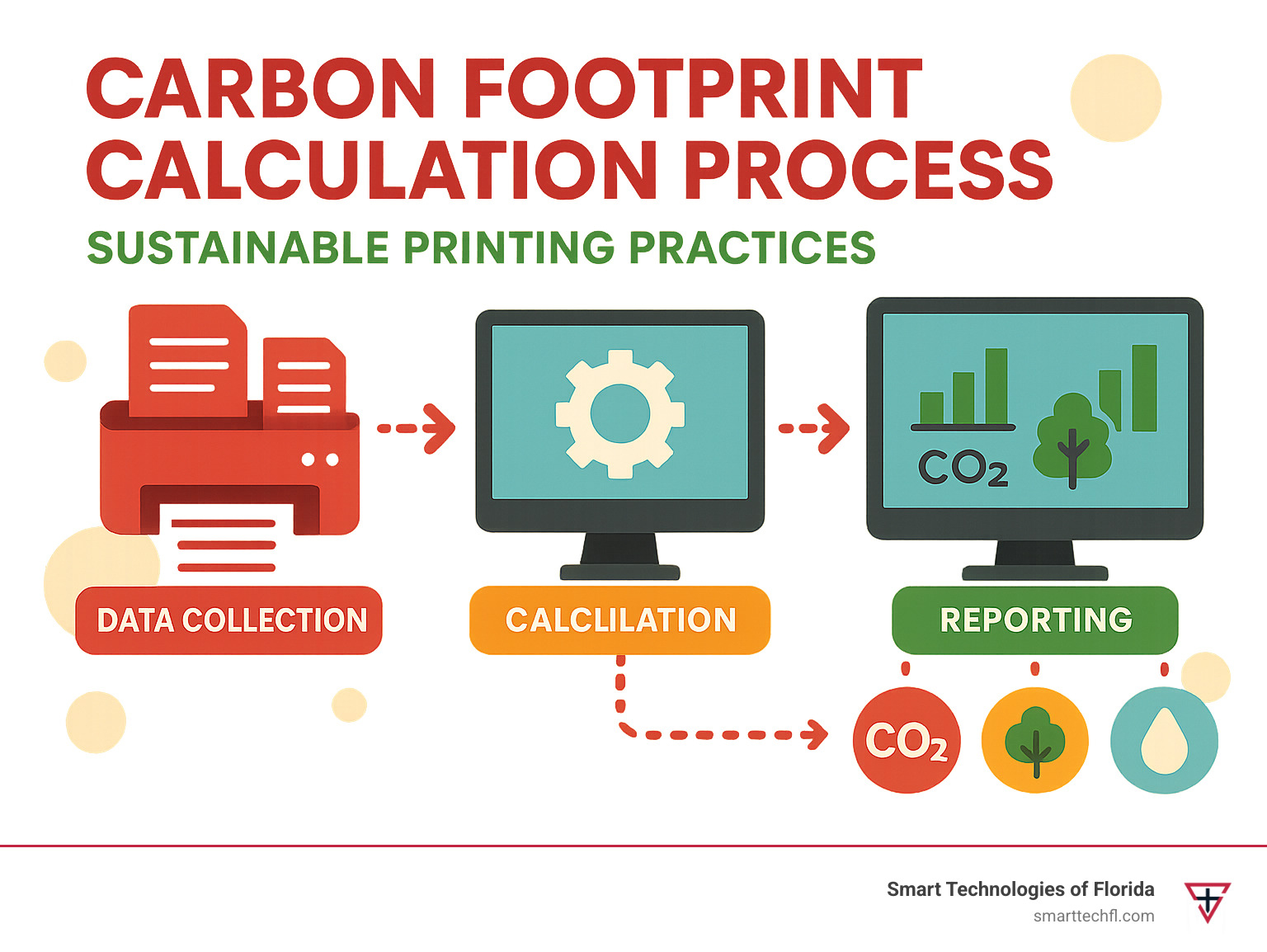
For businesses concerned with Environmental, Social, and Governance (ESG) reporting, these tools generate sustainability reports that align with increasingly stringent standards. Many companies are going a step further with carbon-balanced printing programs that offset the carbon footprint of print jobs through verified carbon reduction projects.
The most advanced systems now evaluate environmental impact across the entire lifecycle—from raw material extraction through end-of-life disposal. This holistic view helps businesses understand and minimize their total environmental footprint, not just the direct impacts of printing.
Supply chain transparency has also improved dramatically, with systems that track and report on the sustainability credentials of all materials and processes involved in printing. This level of transparency wasn’t possible just a few years ago but is now becoming standard practice.
In 2025, these innovations aren’t just nice-to-have features—they’re becoming expected for businesses committed to sustainability. At Smart Technologies of Florida, we help organizations implement these cutting-edge solutions as part of their broader digital change strategy, making sustainability not just achievable but advantageous for your bottom line.
Implementation Roadmap & Cost Savings
Turning sustainable printing practices into reality doesn’t have to be complicated—and the best part? Your wallet will thank you as much as the planet. Let’s walk through how to make this happen in your organization, and the very real savings you can expect along the way.
Step-by-Step Office Rollout
Think of implementing sustainable printing as a journey rather than a destination. Start by conducting a thorough baseline audit to understand where you are today. This means documenting your current print volumes, associated costs, and environmental impact. It’s like taking a “before” picture—you can’t celebrate progress if you don’t know where you started!
Once you have your baseline, set specific goals that everyone can rally behind. Aim for something achievable yet meaningful—maybe reducing paper consumption by 30% within six months, or cutting energy usage by a specific percentage.
The early momentum comes from quick wins that deliver immediate results. Configure all your printers for double-sided printing by default. Enable those energy-saving deep sleep modes. Set up paper reuse trays near printers for those single-sided sheets that still have life in them. These simple changes cost almost nothing but start saving money immediately.
Developing a sustainable procurement policy is your next step. This means establishing clear criteria for purchasing recycled paper, eco-friendly toners, and energy-efficient devices. When it’s time to replace equipment, look for those ENERGY STAR ratings and low TEC (Typical Electricity Consumption) values.
Print management software becomes your best friend in this journey. These tools let you implement secure release printing (no more abandoned print jobs!), set up rules-based printing, and track usage across your organization.
Don’t underestimate the human element in all this. Your team needs training, but they also need champions—those enthusiastic colleagues who will encourage others and keep the momentum going. Create simple visual guides near printers, recognize positive behavior changes, and celebrate successes together.
Partnering with a Sustainable Print Service
Sometimes, bringing in the experts makes all the difference. When looking for a sustainable print partner, do your homework. Check that they practice what they preach with their own documented sustainability policies. Look for recognized certifications like ISO 14001, and ensure they offer comprehensive solutions rather than piecemeal fixes.
The right partner will manage the entire lifecycle of your printing ecosystem—from initial assessment through implementation, and eventually, responsible disposal and recycling. Some providers even offer carbon offset programs that plant trees or invest in renewable energy to balance your printing footprint.
At Smart Technologies of Florida, we’ve spent 23 years helping organizations transform their printing practices, and we’ve seen how partnerships accelerate progress. Our clients benefit from our specialized expertise, access to better pricing on sustainable materials through our economies of scale, and ongoing optimization as technologies evolve.
Measuring Progress & Reporting
As the saying goes, “What gets measured gets managed.” Tracking your printing KPIs is essential for maintaining momentum and demonstrating value. Monitor pages per user, the ratio of color to black and white printing, duplex percentages, and environmental metrics like trees saved and carbon avoided.
Make this data visible and meaningful. Quarterly reviews help you stay on track, while annual sustainability reports showcase your commitment to stakeholders. Employee dashboards can create healthy competition between departments, and executive summaries demonstrate the ROI to leadership.
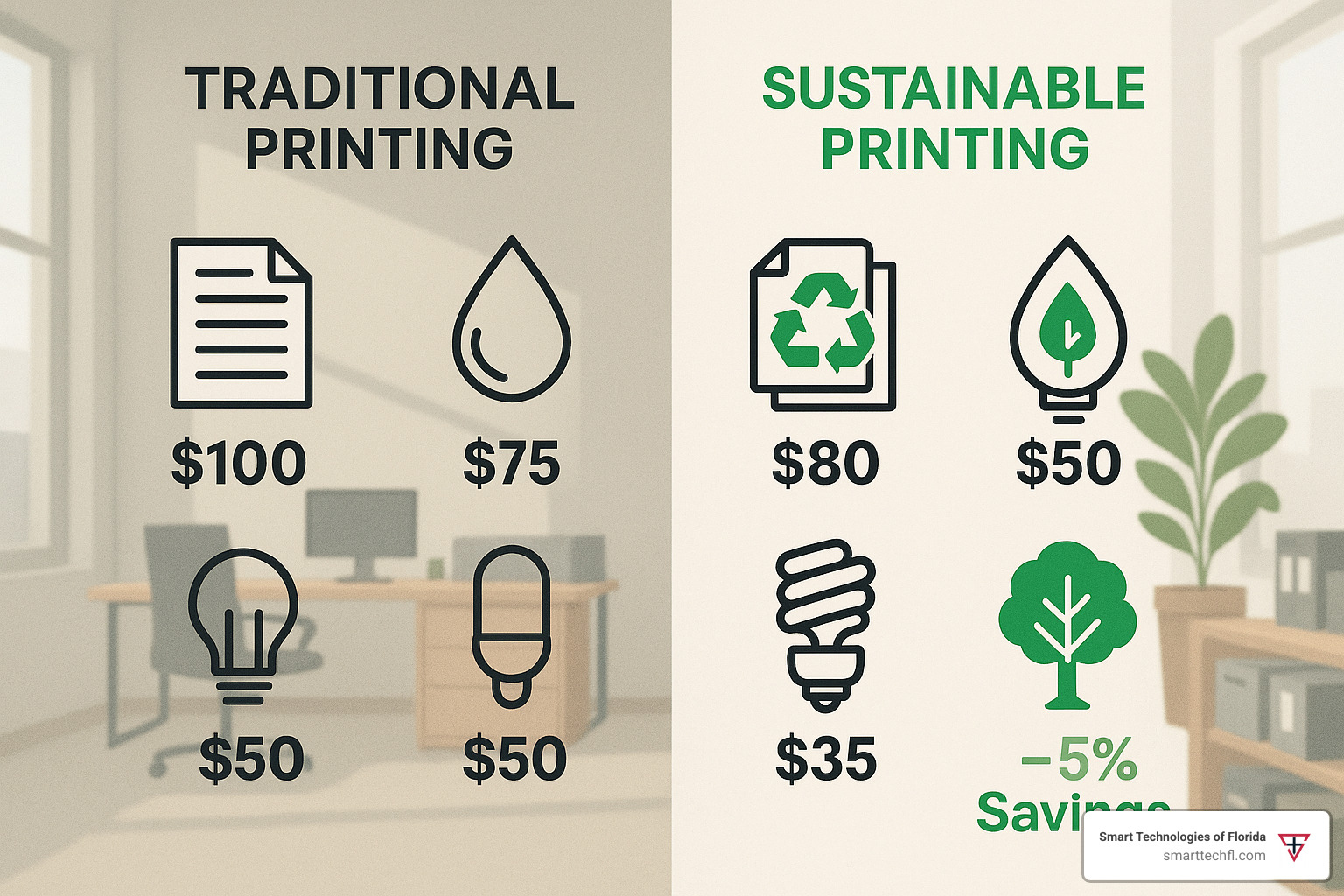
The financial impact of sustainable printing is substantial. While recycled paper might cost slightly more per case than virgin paper, you’ll use 20-40% less of it overall. Eco-mode printing reduces ink and toner costs by 15-30%. Energy-efficient devices can cut electricity bills by 40-60%. Even your IT team benefits, with printer-related help desk tickets dropping by 25-45%.
When you add it all up, the typical organization saves between $2,000-10,000 annually per 10 employees. And that’s before counting potential tax incentives, grants, and the improved brand value that comes with sustainable practices.
This isn’t theoretical—we’ve watched these savings materialize across organizations of all sizes and industries. The return on investment is clear, measurable, and often comes faster than expected. Your printing practices can be good for both the planet and your profit margins—and we’re here to help you make that happen.
Frequently Asked Questions about Sustainable Printing
What are the best sustainable printing practices for small businesses?
Small businesses don’t need big budgets to make a meaningful environmental impact. With limited resources, you can still create significant change by starting small and building gradually.
Begin with simple behavior changes that cost nothing to implement. Set your printers to default to duplex printing, encourage everyone to use print preview before sending jobs, and accept digital alternatives whenever possible. These small adjustments can cut your paper usage dramatically.
Rather than maintaining separate devices for different functions, consider investing in a single ENERGY STAR certified multi-function device. This consolidation reduces energy consumption, saves space, and typically lowers your overall costs.
Even without fancy software, basic print tracking can reveal surprising insights. A simple spreadsheet tracking print volumes can help identify waste and highlight opportunities for improvement that you might otherwise miss.
Using recycled paper and remanufactured cartridges has become both easier and more affordable. These products now perform reliably while significantly reducing environmental impact—and they’re priced competitively with standard options.
Don’t overlook the importance of regular maintenance. Well-maintained equipment runs more efficiently, produces better quality output, and lasts longer—all of which benefit both your budget and the planet.
For small businesses in the Daytona Beach area, we at Smart Technologies of Florida can design custom solutions that align with your current needs while building in room to grow, ensuring your sustainable printing practices evolve alongside your business.
How much can I really save by switching to eco-friendly printing?
When clients ask about the financial benefits of sustainable printing, they’re often surprised by just how substantial the savings can be. The numbers tell a compelling story that goes far beyond just “doing good.”
You’ll see immediate direct material savings of 20-40% on paper costs through simple changes like duplex printing and digital workflows. Many businesses don’t realize how much paper ends up unused or immediately discarded until they start tracking it.
Your electricity bills will reflect energy savings of 30-60% when you switch to ENERGY STAR devices with proper power management settings. Modern equipment is dramatically more efficient than models from even five years ago.
Smart print settings and reduced volume translate to 15-30% savings on ink and toner—consumables that represent a significant portion of printing costs for most organizations.
Beyond these direct savings, you’ll notice productivity gains as employees spend less time dealing with printing issues and more time on valuable work. Your IT team will especially appreciate the reduced help-desk burden, freeing them to focus on more strategic initiatives.
Don’t forget potential tax incentives for energy-efficient equipment and sustainable business practices, which can further improve your return on investment.
Most of our clients achieve full ROI on their sustainable printing investments within 6-12 months, making this one of the smartest and most immediate sustainability initiatives available. We’ve seen businesses reduce their total print-related costs by 20-30%—translating to thousands or even tens of thousands of dollars annually.
Which certifications should I look for on paper and printers?
Navigating environmental certifications can feel overwhelming, but focusing on a few key standards will help ensure your choices make a genuine difference.
For paper, the gold standard is the Forest Stewardship Council (FSC) certification, which guarantees your paper comes from responsibly managed forests. Similarly reliable are the Programme for the Endorsement of Forest Certification (PEFC) and the Sustainable Forestry Initiative (SFI), which verify sustainable forestry practices.
Pay attention to Post-Consumer Waste (PCW) percentage—higher numbers indicate more recycled content. For the most environmentally sensitive documents, look for Processed Chlorine Free (PCF) paper, which avoids harmful bleaching processes.
For printers and equipment, start with ENERGY STAR certification, which identifies truly energy-efficient models. The Electronic Product Environmental Assessment Tool (EPEAT) rating provides a comprehensive environmental assessment of electronic products.
International standards like Germany’s Blue Angel (Der Blaue Engel) and the Scandinavian Nordic Swan apply particularly stringent environmental criteria. RoHS compliance ensures your equipment restricts the use of hazardous substances.
For inks and toners, look for the American Soybean Association Certification for soy-based inks, EcoLogo certification for environmentally preferable products, and GREENGUARD certification, which ensures low chemical emissions.
When selecting a print service provider, ask about their environmental management systems—particularly ISO 14001 certification—and chain-of-custody certifications that ensure traceability of sustainable materials.
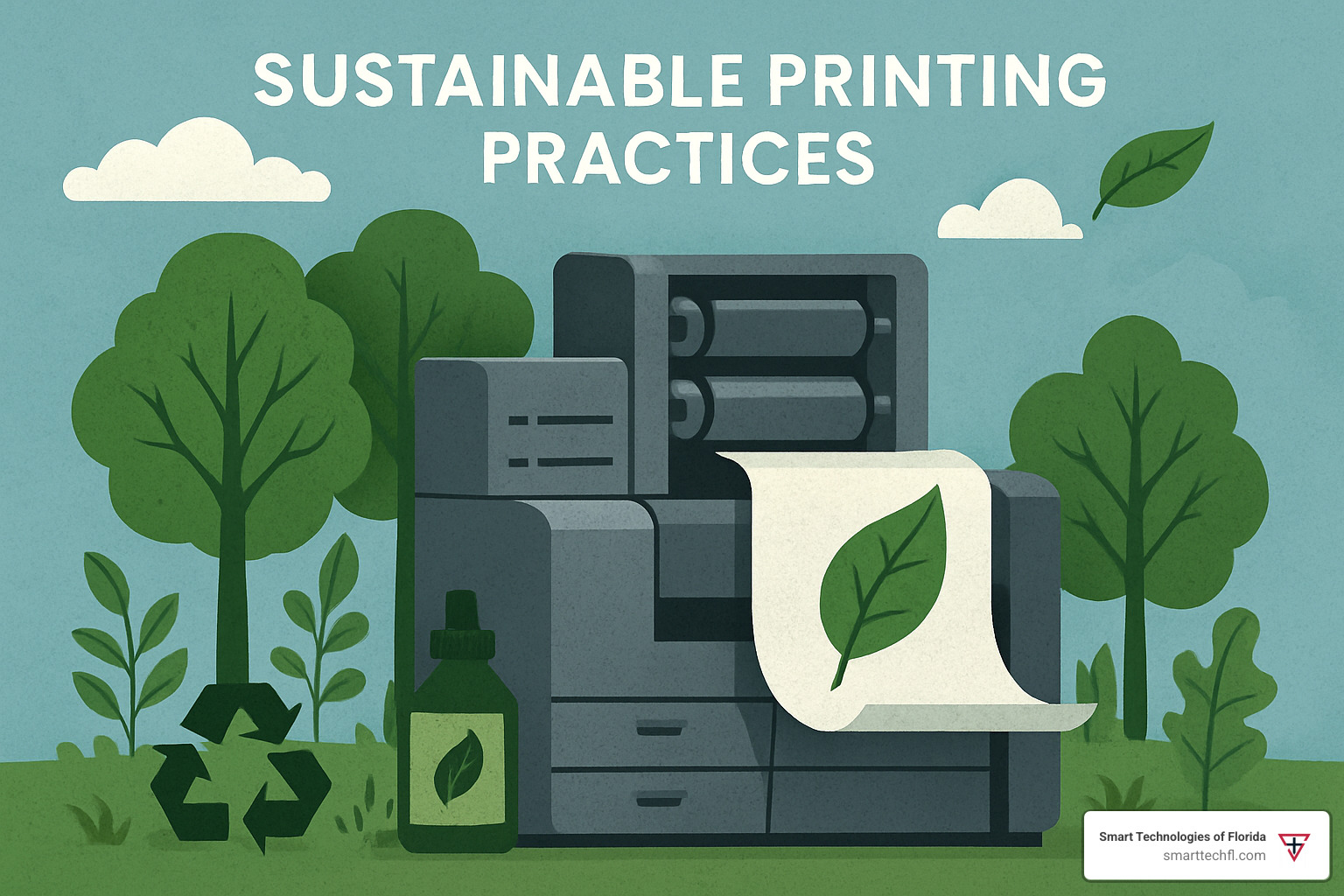
At Smart Technologies of Florida, we help businesses steer these certifications to ensure their sustainable printing practices align with both environmental goals and regulatory requirements. We believe that making environmentally sound choices shouldn’t require a specialized degree—just the right partner to guide you through the options.
Conclusion
There’s a quiet revolution happening in offices around the world. Businesses are finding that sustainable printing practices aren’t just good for the planet—they’re changing bottom lines, streamlining operations, and winning customer loyalty.
Throughout this guide, we’ve seen how small changes add up to significant impact. From choosing recycled paper to implementing smart fleet management, each step reduces your environmental footprint while delivering measurable business benefits. The innovations of 2025 have made sustainable printing more accessible and effective than ever before, turning what was once considered a cost center into a strategic advantage.
But perhaps the most powerful aspect of sustainable printing is how it connects environmental responsibility with practical business sense. When you reduce unnecessary printing, you’re not just saving trees—you’re cutting costs. When you choose energy-efficient equipment, you’re lowering both carbon emissions and utility bills. It’s a rare win-win that smart businesses are embracing wholeheartedly.
At Smart Technologies of Florida, we’ve spent 23 years helping organizations steer digital change with a human touch. We understand that true change isn’t just about implementing new technologies—it’s about bringing people along on the journey. That’s why our approach to sustainable printing encompasses not just hardware and software solutions, but also the training, support, and strategic guidance that ensures lasting success.
We believe that sustainability should be accessible to businesses of all sizes. Whether you’re a small retail shop looking to make simple improvements or a large enterprise seeking comprehensive managed print services, we tailor our solutions to your unique needs, goals, and culture.
As we face growing environmental challenges, every page not printed, every kilowatt-hour saved, and every cartridge recycled makes a difference. By embracing sustainable printing practices, you’re not just reducing your environmental impact—you’re positioning your business for success in a world where sustainability is increasingly valued by customers, employees, and communities.
Ready to take the next step toward more sustainable, efficient printing? We’re here to help you steer the options, implement the right solutions, and measure your success. Together, we can create printing practices that are better for your business and better for our planet.





